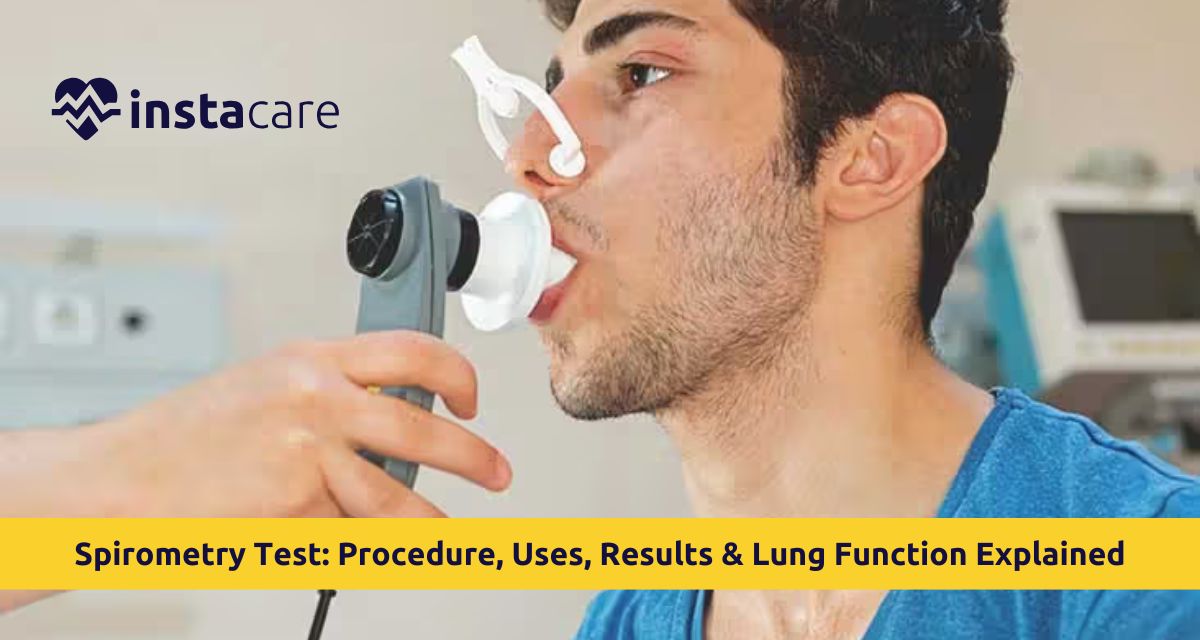What Is a Spirometry Test?
Spirometry is an outpatient pulmonary function test that measures the rate and amount of airflow in and out of the lungs, which allows for the detection and monitoring of a wide range of lung diseases. Spirometry is standard respiratory testing or a pulmonary function testing panel in the majority of instances. Spirometry tests are of specific assistance in the diagnosis of obstructive and restrictive lung disease such as asthma and COPD (Chronic Obstructive Pulmonary Disease).
Procedure for Spirometry Test
Before the Test
Preparation for the spirometry test procedure is very important. You may be required to:
- Miss heavy meals before you are tested.
- Not smoke for several hours.
- Stop inhalers or bronchodilators, if recommended by your doctor.
- Wear loosely comfortable clothing.
Your weight, height, age, and sex are noted, since these affect standard spirometry values.
Taking the Test
You will sit and will need to put a clip on your nose. You will exhale through an instrument named spirometry using a mouthpiece. The test includes:
- Breathing deep in.
- Blowing quickly and hard through the mouthpiece.
- Repeating it several times trying to get a good reading.
It makes two extremely important measurements: Forced Vital Capacity (FVC) and forced expiratory volume (FEV1) in one second.
Pre and Post Bronchodilator Test
In some cases, a pre and post bronchodilator test is done. First, spirometry is performed normally. Then, you’ll inhale a bronchodilator medication (to relax airway muscles), and the test is repeated after 15–20 minutes. This helps assess how responsive your airways are to treatment, key in diagnosing conditions like asthma and
COPD.
Key Measurements: FVC and FEV1
Two of the most important values measured during spirometry are:
Forced Vital Capacity (FVC)
FVC is the volume of air which you are able to blow out forcefully following maximal inspiration. It is an approximation of your lung capacity.
Forced Expiratory Volume in One Second (FEV1)
FEV1 is an approximation of the volume of air which you can blow out forcefully during the initial one second of the FVC maneuver. FEV1 is a very helpful measurement in airway obstructive diagnosis.
FEV1/FVC ratio is employed for the differentiation of obstructive from restrictive lung disease.
Spirometry Test Results Explained
Normal Results
Normal spirometry test results explained are age, sex, height, and ethnicity dependent. Spirometry normal values in spite of these are as follows:
- FEV1: ≥80% predicted
- FVC: ≥80% predicted
- FEV1/FVC ratio: ≈70–80%
These are normal lung function values.
Abnormal Results
- Decreased FEV1/FVC ratio is usually seen with obstructive lung diseases like COPD or asthma.
- Low FVC but normal or elevated FEV1/FVC would indicate restrictive lung disease, i.e., pulmonary fibrosis.
The values must be interpreted correctly, and that's why spirometry must always be interpreted by experts.
Read More: Creatinine Test – Purpose, Normal Range, and Kidney Function Insight
Spirometry Uses in Asthma and COPD
Spirometry Use in COPD Diagnosis
Spirometry for COPD diagnosis is the most accurate test. Post-bronchodilator FEV1/FVC below 70% confirms chronic airflow limitation, which is typical of COPD.
Spirometry Uses in Asthma
Spirometry uses in asthma is helpful in:
- Diagnosis if there are features like cough, wheeze, and breathlessness.
- Monitoring of response to treatment.
- Serial assessment of control of asthma.
Pre and post bronchodilator test is very helpful, since asthmatic patients otherwise show a marked improvement in FEV1 after receiving a bronchodilator.
Pulmonary Function Test vs. Spirometry
A pulmonary function test or PFT is a series of tests to assess lung volume, capacity, flow rates, and gas exchange. Spirometry is merely one part of the entire PFT. Spirometry quantitatively measures airflow, but other tests like body plethysmography and diffusion capacity quantitatively measure lung volumes and oxygen capacity for transfer.
They provide a better determination of lung status when used together.
Preparation for Spirometry
Right preparation equals right results. Here is how to prepare for spirometry:
- Avoid caffeine and heavy meals hours in advance of the test.
- Avoid smoking at least 4–6 hours prior.
- Avoid skipping drugs unless your physician instructs you.
- Loose clothing that will not restrict chest movements.
- Carry a list of current medications and medical history.
- Always adhere to special instructions instructed by your healthcare provider.
Learning the Spirometry Machine
The spirometry machine is a mouthpiece and flow sensor attached to a computer that measures the volume and rate of air you exhale. Modern-day spirometers are equipped with digital readout, real-time cues, and instant feedback to help the patient perform the test correctly.
Some of the machines are equipped with software to perform sophisticated spirometry analysis prior to time to make it convenient for clinicians to detect problems early and accurately.
Spirometry Side Effects and Risk
Spirometry is safe, yet there are some minor spirometry side effects of spirometry that can manifest themselves, and they are:
- Dizziness or dizziness when necessary to force-exhale
- Difficulty in breathing when breathing after a test
- Sore throat or coughing
In some, those with uncontrolled medical heart disease or those with recent surgery may be poor candidates for the test. Always inform your doctor of any ongoing medical illnesses beforehand.
Advantages of Spirometry Testing
- Early Diagnosis: Identifies lung diseases before they become advanced.
- Monitoring Treatment: Checks for improvement and treatment response.
- Surgical Clearance: Enables risk stratification before surgery.
- Occupational Safety: Used in those occupations that expose workers to lung irritants.
It is rapid, painless method of learning about lung function with instant feedback and quick clinical action.
Limitations of Spirometry
- Even though extremely useful, spirometry has the following drawbacks:
- It cannot measure all lung diseases, especially small airway or parenchymal lung diseases.
- Test result is effort dependent, i.e., patient's cooperation.
- Result needs to be interpreted in view of clinical history and other investigations.
It is because of this that spirometry is among a sequence of tests utilized throughout an amplified evaluation of the respiratory system.
Final Thoughts
The spirometry technique is a standard diagnosis device in current respiratory medicine. By measuring the amount of airflow to aid in diagnosing chronic conditions like COPD and asthma, it helped avoid as well as diagnose earlier. Spirometry results are easy to interpret with it, hence the physician can take timely and consistent decisions, thus improving patient treatment.
Whether you’re facing breathing issues or simply monitoring your health, a lung function test like spirometry offers valuable insights. Proper preparation, understanding the results, and working closely with your doctor can make all the difference in maintaining healthy lungs.
Please book an appointment with the
Best Pulmonologist in Lahore, Karachi, Islamabad, and all major cities of Pakistan through
InstaCare, or call our helpline at 03171777509 to find the verified doctor for your disease.

